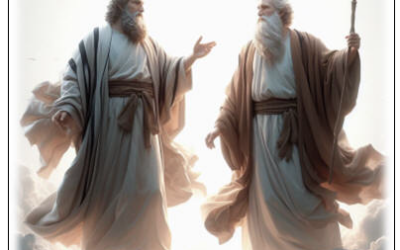In 1611, when the KJV was produced, the translators used the word “unicorn” to translate a single Hebrew word, רְאֵם reym, because they didn’t know what the original Hebrew word meant. It is the English that critics complain about, not the original Hebrew text. Let’s take a look at a few of the verses in the KJV that use the word “unicorn.”
- Job. 39:9-10 KJV, “Will the unicorn be willing to serve thee, or abide by thy crib? 10 Canst thou bind the unicorn with his band in the furrow? or will he harrow the valleys after thee?”
- Psalm 22:21 KJV, “Save me from the lion’s mouth: for thou hast heard me from the horns of the unicorns.”
- Isaiah 34:7 KJV, “And the unicorns shall come down with them, and the bullocks with the bulls; and their land shall be soaked with blood, and their dust made fat with fatness.”
- See also KJV in Num. 23:22; Nu. 24:8; Deut. 33:17; Psalm 29:6; 92:10.
In every occurrence of the English word “unicorn,” it is the same Hebrew word ראם reym.
- רְאֵם [râʾem, râʾeym, reym, rem /reh·ame/] n m. From 7213; TWOT 2096a; GK 8028; Nine occurrences; AV translates as “unicorn” nine times. 1 probably the great aurochs or wild bulls which are now extinct. The exact meaning is not known.1
- reem or רְאֵים reem or רֵים rem or רֵם rem (910b); from 7213; a wild ox:—wild ox(7), wild oxen(2).2
- 8028 רְאֵם (reʾēm): n.masc.; ≡ Str 7214; TWOT 2096a—1. LN 4.1–4.37 (most versions) wild ox, aurochs, i.e., an extinct, long-horned, ancestor of the domestic cattle, Bos primigenius bojanus (Nu 23:22; 24:8; Dt 33:17; Job 39:9, 10; Ps 22:21[EB 21]; 92:11[EB 10]; Isa 34:7+), note: kjv, lxx, VULG. translate as a single-horned animal, such as rhinoceros or mysterious unicorn; 2. LN 4.1–4.37 unit: בֵּן רְאֵם (bēn reʾēm) adolescent wild ox, i.e., a non-domestic ox likely under two years old (Ps 29:6+)3
Critics
Of course, critics will just say that the Bible translators altered the English to escape the inclusion of mythical creatures. But again, they must realize that the KJV is in English and it is the English they are complaining about, not the original Hebrew word.
- UNICORN kjv rendering for an animal called a “wild ox” in the nlt and most modern translations (Nm 24:8; Dt 33:17). Unicorn is an unfortunate translation (following the Septuagint) because the animal had two horns, not one. See Animals (Wild Ox). 4
- Unicorn — described as an animal of great ferocity and strength (Num. 23:22), R.V., “wild ox,” marg., “ox-antelope;” 24:8; Isa. 34:7, R.V., “wild oxen”), and untamable (Job 39:9). It was in reality a two-horned animal; but the exact reference of the word so rendered (reem) is doubtful. Some have supposed it to be the buffalo; others, the white antelope, called by the Arabs rim. Most probably, however, the word denotes the Bos primigenius (“primitive ox”), which is now extinct all over the world. This was the auerochs of the Germans, and the urus described by Caesar (Gal. Bel., vi.28) as inhabiting the Hercynian forest. The word thus rendered has been found in an Assyrian inscription written over the wild ox or bison, which some also suppose to be the animal intended (comp. Deut. 33:17; Ps. 22:21; 29:6; 92:10).5
The LXX – Septuagint
The LXX (The Greek translation of the Old Testament done around 250 B.C.) says of Job 39:9, βουλήσεται δέ σοι μονόκερως δουλεῦσαι ἢ κοιμηθῆναι ἐπὶ φάτνης σου. The Greek word μονόκερως monokeros is what the Hebrews tranlsated the Hebrew word רְאֵם reym into. It is an unfortunate rendering. It literally means “one horn,” and this is why the KJV rendered it as unicorn since it was using the LXX and not the original Hebrew here.
References
| 1↑ | Strong, J. (1996). The exhaustive concordance of the Bible: Showing every word of the text of the common English version of the canonical books, and every occurrence of each word in regular order. (electronic ed.). Ontario: Woodside Bible Fellowship. Emphasis added |
|---|---|
| 2↑ | Thomas, R. L. (1998). New American Standard Hebrew-Aramaic and Greek dictionaries : Updated edition. Anaheim: Foundation Publications, Inc. Emphasis added |
| 3↑ | Swanson, J. (1997). Dictionary of Biblical Languages with Semantic Domains : Hebrew (Old Testament) (electronic ed.). Oak Harbor: Logos Research Systems, Inc. Emphasis added |
| 4↑ | lwell, W. A., & Comfort, P. W. (2001). Tyndale Bible dictionary. Tyndale reference library (1280). Wheaton, Ill.: Tyndale House Publishers.Emphasis added |
| 5↑ | Easton, M. (1996). Easton’s Bible dictionary. Oak Harbor, WA: Logos Research Systems, Inc. Emphasis added |






